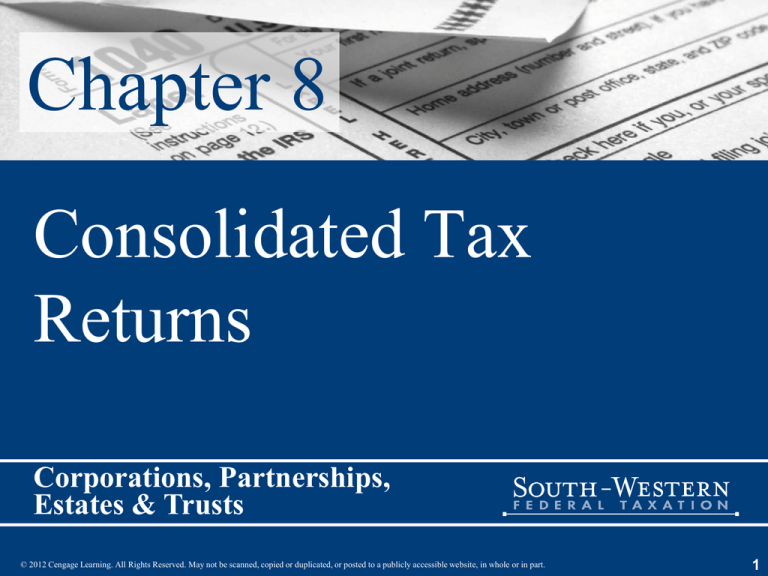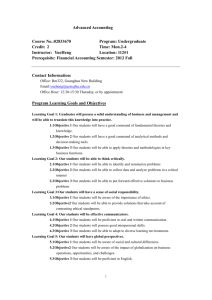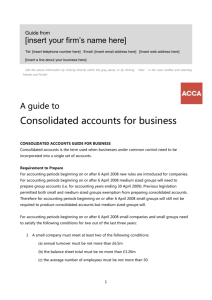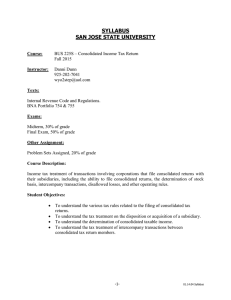
Chapter 8
Consolidated Tax
Returns
Corporations, Partnerships,
Estates & Trusts
© 2012 Cengage Learning. All Rights Reserved. May not be scanned, copied or duplicated, or posted to a publicly accessible website, in whole or in part.
1
The Big Picture (slide 1 of 2)
• Alexander Corporation has had a long-term association with
one of its suppliers, Hamilton Corporation.
– In the past, Hamilton was a highly profitable operation and was even
able to make loans to Alexander to cover short-term working capital
needs.
– Recently, however, Hamilton has been less reliable, but Alexander
feels confident that Hamilton’s fortunes will improve.
• If this financial turnaround occurs, Alexander will continue dealing with
Hamilton.
• Alexander’s tax advisers have suggested that Alexander
consider acquiring Hamilton in a merger or other takeover that
qualifies as a tax-favored reorganization (see Chapter 7).
The Big Picture (slide 2 of 2)
• Acquisition of Hamilton offers several advantages.
– Hamilton has large net operating losses that Alexander could use on
future joint tax returns.
– Hamilton’s name, reputation, and location still have value in the
marketplace.
• It could continue as a separate division or subsidiary of Alexander.
• Furthermore, the takeover would give other businesses greater assurance of
Hamilton’s financial viability.
– Lastly, there could be other tax advantages to Alexander, the new
parent of a two-corporation group.
• Evaluate this and other viable alternatives for Alexander
taking into account various possible outcomes (e.g., the
success or failure of Hamilton’s business).
• Read the chapter and formulate your response.
Reasons for Using Multiple Entities
(slide 1 of 3)
• Isolate assets of certain ventures from
liabilities of other ventures (i.e., obtain limited
liability)
• Carry out estate planning objectives
Reasons for Using Multiple Entities
(slide 2 of 3)
• Define upper limit on losses in joint venture
with outside party by establishing minimally
funded subsidiary to participate in venture
• Shield identities of true owners of venture
Reasons for Using Multiple Entities
(slide 3 of 3)
• Enhance market value of entity assets by
taking advantage of goodwill or trade names of
certain members
Consolidated Return Advantages
(slide 1 of 3)
• Current losses can offset income of other
members and reduce current regular tax or
AMT
• Operating and capital loss carryovers of one
member may be used to offset income of other
members
Consolidated Return Advantages
(slide 2 of 3)
• Taxation of intercompany dividends may be
eliminated
• Income on certain intercompany transactions
can be deferred
Consolidated Return Advantages
(slide 3 of 3)
• Certain deductions and tax credits can be
better utilized when subject to limitations of
overall group rather than individual members
• Basis in stock owned in lower tier entities is
increased as income is reported
Consolidated Return Disadvantages
(slide 1 of 3)
• Election is binding on all members for current
and all subsequent years’ returns
• Election may be terminated if:
– IRS consents to revocation, or
– If membership in group changes and new member
is not included in election
Consolidated Return Disadvantages
(slide 2 of 3)
• Losses on intercompany transactions are
deferred
• Certain deductions and tax credits may be
reduced if limitations are determined based on
activities of entire group
Consolidated Return Disadvantages
(slide 3 of 3)
• Basis in stock owned in lower tier entities is
reduced if losses from the subsidiary are
reported
• Additional reporting requirements exist, and
additional administrative procedures are
necessary
The Consolidated Return Election
Electing Consolidated Return Status
• A corporation can elect to join in a
consolidated return if:
– It is a member of an affiliated group
– It is not ineligible to file on a consolidated basis
– It meets initial and ongoing requirements
Affiliated Group
(slide 1 of 3)
• Exists when one corporation owns at least 80%
of voting power and stock value of another
corporation
– Ownership test must be met every day of tax year
– Multiple tiers and chains of corporations are
allowed
– Must have an identifiable parent corporation
• At least 80% of one corporation must be owned by
another
Affiliated Group
(slide 2 of 3)
• Affiliated group members can file tax returns
in two ways:
– Each member files a separate return
• Claim a 100% dividends received deduction for
payments passing among them
– Elect to file consolidated tax returns
• No 100% dividends received deduction is allowed for
payments among group members
• Election may not be binding for state purposes
Affiliated Group
(slide 3 of 3)
Affiliated Versus
Controlled Group
• An affiliated group is similar but not identical to a
parent-subsidiary controlled group
• Members of a controlled group are
– Required to share a number of tax benefits, including:
• Discounted marginal tax rates on the first $75,000 of taxable
income
• The $150,000 or $250,000 accumulated earnings credit
• The $40,000 exemption in computing AMT liability
– Must defer recognition of realized loss on intercompany
sales until sale is made at a gain to a nongroup member
– Must recognize as ordinary income gain on the sale of
depreciable property between controlled group members
Parent-subsidiary
Controlled Group
• Exists when one corporation owns at least 80%
of voting power or stock value of another
corporation on the last day of the year
– Can have multiple tiers of subsidiaries and chains
of ownership
– Must have an identifiable parent
Entities Not Eligible for
Consolidation Election
• Entity type:
– Corporations established outside the US or in a US
possession
– Tax-exempt (charitable) corporations
– Insurance companies
– Partnerships, trusts, estates, limited liability entities, or
other noncorporate entities
• These corporations cannot be used to meet the stock
ownership tests and their incomes cannot be included
in the consolidated return
Are these Eligible Groups?
Compliance Requirements
(slide 1 of 5)
• Initial consolidated return must meet the
following requirements:
– Form 1120 should include income of all members
of consolidated group
– Form 1122 is filed with first consolidated tax
return
• Represents consent by all entities to be included in
consolidated group
– Election must be made no later than the extended
due date of parent’s return
Compliance Requirements
(slide 2 of 5)
• Subsequent consolidated returns:
– Form 851 is included, which identifies all group
members and shareholdings among the members
– Form 851 also lists estimated tax payments made
by any member during year
Compliance Requirements
(slide 3 of 5)
• Liability for taxes:
– Each member is jointly and severally liable for
entire consolidated tax liability, penalties and
interest
– Starting with third consolidated tax year, estimated
tax payments must be made on consolidated basis
Compliance Requirements
(slide 4 of 5)
• Tax liability calculation
– Regular tax is determined using graduated tax rates on
consolidated income
– Lower tax brackets are allocated equally to all members
unless an election is made to allocate such benefits
differently
– Alternative minimum tax liability is based on consolidated
AMTI of group
• Group gets only one $40,000 exemption
• ACE adjustment is computed using consolidated amounts
Compliance Requirements
(slide 5 of 5)
• Accounting periods and methods:
– Tax year of parent must be used by all members
• Short-year return may be required for the first year a
subsidiary is included in the consolidated return
– Accounting methods in place at the date of the
election continue to be used
The Big Picture – Example 13
Compliance Requirements (slide 1 of 2)
• Return to the facts of The Big Picture on p. 8-2.
• Assume that both Alexander and Hamilton use
calendar tax years, and that they wish to file
their Federal income tax returns on a
consolidated basis starting with the 2011 tax
year.
– Alexander does not elect an extended due date for
its 2011 return.
The Big Picture – Example 13
Compliance Requirements (slide 2 of 2)
• For the consolidation election is to be effective
– Alexander must file a Form 1120 that includes the taxable
income/(loss) for both corporations by March 15, 2012.
– Hamilton must execute a Form 1122 and attach it to the
consolidated Form 1120.
• If Alexander and Hamilton convert their separate tax
returns to the consolidated format in this manner
– The election in force for all future tax years, or
– Until the IRS approves Alexander’s application to revoke
it.
Stock Basis of Subsidiary
(slide 1 of 7)
• Parent corporation’s basis in the subsidiary’s
stock is:
– Initially, the acquisition price
– Adjusted at end of each tax year
• Prevents double taxation of gain or loss on ultimate
disposal of subsidiary’s shares
Stock Basis of Subsidiary
(slide 2 of 7)
• Positive adjustments: Basis in subsidiary is
increased by:
– Allocable share of consolidated taxable income for
year
– Allocable share of consolidated operating or
capital loss of subsidiary that could not use the loss
through carryback to a prior year
– Contributions to capital of subsidiary
Stock Basis of Subsidiary
(slide 3 of 7)
• Negative adjustments: Basis in subsidiary is
reduced by:
– Allocable share of consolidated taxable loss for
year
– Allocable share of operating or capital loss
carryover deducted on consolidated return which
did not previously reduce basis in subsidiary’s
stock
– Dividends paid by subsidiary to the parent out of
E&P
Stock Basis of Subsidiary
(slide 4 of 7)
• When postacquisition taxable losses of
subsidiary exceed acquisition price, an excess
loss account is established
– Allows consolidated return to recognize losses of
subsidiary in current year
– Enables group to avoid reflecting a negative stock
basis in subsidiary
Stock Basis of Subsidiary
(slide 5 of 7)
• If stock of subsidiary is redeemed or sold to
third party, any balance in excess loss account
is recognized as capital gain
Stock Basis of Subsidiary
(slide 6 of 7)
• In a chain of more than one tier of subsidiaries,
begin computation of stock basis in lowestlevel subsidiary
– Proceed up the ownership structure to parent
Stock Basis of Subsidiary
(slide 7 of 7)
• There is no such concept as consolidated
E&P
– Each entity accounts for its share of consolidated
taxable income
– Immediately recognizes within E & P any deferred
gain or loss on intercompany transactions
– Reduces E & P by allocable share of consolidated
tax liability
The Big Picture – Example 18
Stock Basis Of Subsidiary (slide 1 of 2)
• Return to the facts of The Big Picture on p. 8-2.
• Assume that Alexander acquired all of the
outstanding Hamilton stock on January 1,
2010, for $1 million.
• The parties immediately elected to file
consolidated Federal income tax returns.
The Big Picture – Example 18
Stock Basis Of Subsidiary (slide 2 of 2)
• Hamilton reported a 2010 taxable loss of
$100,000, but it generated $40,000 taxable
income in 2011 and $65,000 in 2012.
• Hamilton paid a $10,000 dividend to
Alexander in mid-2012.
• Alexander holds the following stock bases in
Hamilton on the last day of each of the
indicated tax years.
2010 $900,000 2011 $940,000 2012 $995,000
Computing Consolidated
Taxable Income (slide 1 of 3)
• Sequential Approach:
– Compute taxable income separately for each
member of group
– “Group items” and “intercompany items” are
isolated and receive special treatment
– Remaining separate incomes are combined with
group and intercompany items, resulting in
consolidated taxable income
Computing Consolidated
Taxable Income (slide 2 of 3)
• This computational procedure allows several
transactions to be accounted for on a
consolidated basis
– e.g., charitable contributions, capital gains and
losses
Computing Consolidated
Taxable Income (slide 3 of 3)
Intercompany Transactions
(slide 1 of 4)
• Most intercompany transactions remain in the
members’ separate taxable income
– Effectively cancel each other out on a consolidated
basis
Intercompany Transactions
(slide 2 of 4)
• Most intercompany transactions remain in the
members’ separate taxable income (cont’d)
– e.g., Services provided by one member to another
member
• Services provider recognizes income
• Service purchaser recognizes deductible expense
• Net result is a zero addition to consolidated taxable
income
Intercompany Transactions
(slide 3 of 4)
• When members involved in the intercompany
transaction use different accounting methods
– Payor’s deduction for intercompany expenditure is
deferred until year in which recipient recognizes
the related gross income
Intercompany Transactions
(slide 4 of 4)
• Dividends received from other group members
– Eliminated from recipient’s separate taxable
income
– No dividends received deduction allowed
– If dividend is noncash asset
• Payor member realizes gain but defers recognition until
asset leaves the group
• The (eliminated) dividend amount = FMV of asset
received
Member’s NOLs
(slide 1 of 6)
• Usual corporate provisions for NOLs are
available for consolidated losses
– Carryback 2 years
– Then forward 20 years
– Election to forgo carryback for all members is
available
Member’s NOLs
(slide 2 of 6)
• In computing consolidated NOL
– Remove consolidated charitable contributions and
capital gain or loss from taxable income
• These items have their own carryover periods and rules
– The consolidated dividends received deduction
remains a part of the consolidated NOL
Member’s NOLs
(slide 3 of 6)
• Complications arise when group members
enter or depart from the consolidated group
– Members’ NOLs are either incurred in a “separate
return year” and deducted in a “consolidated return
year” or vice versa
• Several restrictions limit the availability of such NOL
deductions
Member’s NOLs
(slide 4 of 6)
• Where members of consolidated group change
over time, consolidated NOL must be apportioned
to group members using the following formula:
Member’s separate NOL × Consolidated NOL
Members’ aggregate NOL
= Member’s apportioned NOL
Member’s NOLs
(slide 5 of 6)
• In years when group member files a separate
return, only the apportioned NOL may be
carried over
• When member leaves the group, any
apportioned share of unused loss
carryforwards can be used on its subsequent
separate returns
Member’s NOLs
(slide 6 of 6)
• Separate return limitation year (SRLY) rules
apply when NOLs are carried forward from a
separate return year onto a consolidated return
• Consolidated return can include loss from
member’s SRLY period only to lesser of its:
• Current year income, or
• Cumulative positive contribution to current year
consolidated income
Computation of Group Items
(slide 1 of 2)
• Several items are computed on a consolidated basis
including:
–
–
–
–
–
–
–
–
Net capital gain/loss
§ 1231 gain/loss
§ 199 domestic production activities deduction
Casualty/theft gain/loss
Charitable contributions
Dividends received deduction
Net operating loss
AMT adjustments and preferences
Computation of Group Items
(slide 2 of 2)
• Several items are computed on a consolidated
basis (cont’d)
– All of these items are removed from members’
separate taxable income
• Then use consolidated taxable income to that point to
determine statutory limitations for group-basis gains,
losses, income, and deductions
The Matching Rule
(slide 1 of 3)
• Certain intercompany transactions receive
deferral treatment
– Gain or loss realized is removed from taxable
income until the sold asset leaves the group
– Prevents accelerating loss deductions on sales of
assets within the group
The Matching Rule
(slide 2 of 3)
• Certain intercompany transactions receive
deferral treatment (cont’d)
– Applies to the following transactions among group
members:
• Sale of assets
• Performance of services
The Matching Rule
(slide 3 of 3)
• The entire deferred gain or loss is included in
consolidated taxable income when:
– The asset is transferred outside the group
– The transferor of property leaves the group
– Consolidation election is terminated
Refocus On The Big Picture (slide 1 of 3)
• If Alexander and Hamilton qualify, and both
corps. continue to exist as separate entities,
they should consider filing their Federal
income tax returns on a consolidated basis.
– If Hamilton begins to generate positive taxable
income, the NOLs and other attractive tax
attributes that Hamilton brings to the group will be
of great benefit to both corporations.
Refocus On The Big Picture (slide 2 of 3)
• The group also may benefit from other aspects
of Hamilton’s tax situation, including its
accumulated capital and passive losses and
credits that have been carried forward due to a
lack of tax liability.
– In all likelihood, Alexander and Hamilton are a
‘‘good match’’ as potential consolidated return
partners.
Refocus On The Big Picture (slide 3 of 3)
What If?
• But what if Alexander’s expectations for a turnaround
in Hamilton’s business fortunes prove to be incorrect
and the subsidiary continues to generate NOLs?
– The SRLY rules will prevent the deductions and credits
acquired from Hamilton from being of immediate use to the
affiliated group.
– A consolidation election will be beneficial only if the
Hamilton subsidiary generates positive postacquisition
taxable income.
If you have any comments or suggestions concerning this
PowerPoint Presentation for South-Western Federal
Taxation, please contact:
Dr. Donald R. Trippeer, CPA
trippedr@oneonta.edu
SUNY Oneonta
© 2012 Cengage Learning. All Rights Reserved. May not be scanned, copied or duplicated, or posted to a publicly accessible website, in whole or in part.
59







